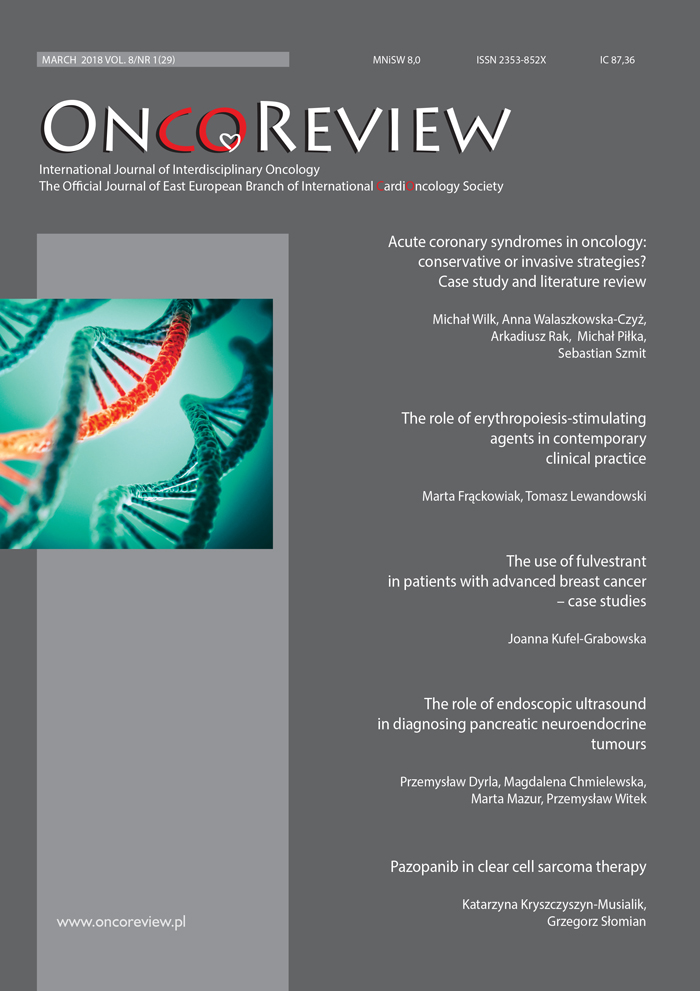The role of erythropoiesis-stimulating agents in contemporary clinical practice Review article
Main Article Content
Abstract
Anaemia is one of the most significant factors that lead to deteriorated quality of life and limited therapeutic possibilities in cancer patients. When treating chronic anaemia associated with a neoplastic disease, one should consider RBC transfusion or the use of recombinant human erythropoiesis-stimulating agents (ESA). In 2007, following the golden era of ESA at the beginning of the 21st century, the American Food and Drug Administration (FDA) issued a number of warnings related to the use of ESAs. They concerned, i.e., the increased risk of cancer progression, probability of venous thromboembolism (VTE), and reduced overall survival times. That has led to a decrease in the use of erythropoiesis-stimulating agents in clinical practice. Results of the most recent studies and meta-analyses indicate the possibility of using ESA in patients undergoing palliative myelosuppressive chemotherapy, with haemoglobin levels < 10 g/dl, and without absolute iron deficiency, in order to avoid red cell concentrate transfusions, and with the hope to improve the patient’s quality of life.
Downloads
Metrics
Article Details

This work is licensed under a Creative Commons Attribution-NonCommercial 4.0 International License.
Copyright: © Medical Education sp. z o.o. This is an Open Access article distributed under the terms of the Attribution-NonCommercial 4.0 International (CC BY-NC 4.0). License (https://creativecommons.org/licenses/by-nc/4.0/), allowing third parties to copy and redistribute the material in any medium or format and to remix, transform, and build upon the material, provided the original work is properly cited and states its license.
Address reprint requests to: Medical Education, Marcin Kuźma (marcin.kuzma@mededu.pl)
References
2. Steensma DP. Is anemia of cancer different from chemotherapy-induced anemia? J Clin Oncol 2008; 26(7): 1022-1024.
3. Tonia T, Mettler A, Robert N et al. Erythropoietin or darbepoetin for patients with cancer. Cochrane Database Syst. Rev. 2012; 12: CD003407. https://doi.org/10.1002/14651858.CD003407.pub5.
4. Grant MD, Piper M, Bohlius J et al. Epoetin and Darbepoetin for Managing Anemia in Patients Undergoing Cancer Treatment: Comparative Effectiveness Update. AHRQ Comparative Effectiveness Reviews 2013; Report No. 13-EHC077-EF.
5. Henke M, Laszig R, Rübe C et al. Erythropoietin to treat head and neck cancer patients with anaemia undergoing radiotherapy: randomised, double-blind, placebo-controlled trial. Lancet 2003; 362(9392): 1255-1260.
6. Leyland-Jones B, Semiglazov V, Pawlicki M et al. Maintaining normal hemoglobin levels with epoetin alfa in mainly nonanemic patients with metastatic breast cancer receiving first-line chemotherapy: a survival study. J Clin Oncol 2005; 23(25): 5960-5972.
7. Leyland-Jones B, Bondarenko I, Nemsadze G et al. A Randomized, Open-Label, Multicenter, Phase III Study of Epoetin Alfa Versus Best Standard of Care in Anemic Patients With Metastatic Breast Cancer Receiving Standard Chemotherapy. J Clin Oncol 2016; 34(11): 1197-1207. https://doi.org/10.1200/JCO.2015.63.5649.
8. Winczura P, Jassem J. Rekombinowana ludzka erytropoetyna w leczeniu niedokrwistości u chorych na nowotwory: nadzieje i zagrożenia. Onkologia w Praktyce Klinicznej 2007; 3(4): 198-204.
9. Rizzo JD, Brouwers M, Hurley P et al. American Society of Clinical Oncology/American Society of Hematology Clinical Practice Guideline Update on the Use of Epoetin and Darbepoetin in Adult Patients with cancer. J Clin Oncol 2010; 28(33): 4996-5010.
10. Stafkey-Mailey D, Dickson M. Changes in use of erythropoetin-stimulating agents (ESAs) in cancer patients: before and after FDA safety advisories. Meeting Library ACO university. June 2, 2012.
11. Sukrithan V, Gralla RJ. Do risks with the use of erythropoetitin stimulating agents (ESAs) differ by tumor type? Implications concerning survival and thrombosis based on meta-analysis (MA). Meeting Library ACO university. June 6, 2016.
12. Dickinson KM, Sakr BJ. ESA use in women with cancer: Consequences of the 2008 FDA clinical alert. Poster at 2012 ASCO Annual Meeting.

